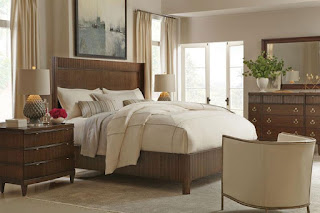This design style is more than just tossing all the rules aside and mixing traditional elements with modern, minimalist or clean-lined furniture. Done well, it creates a beautiful, balanced space. Done not so well, then not so much. If transitional design is something you are interested in, these tips will hep you mix seemingly unrelated styles into a balanced design that works in your home.
Elements of Transitional Design
Mixing classic and contemporary elements is the cornerstone of transitional design. One way to look at it is as a reboot of classic design. Just like any good reboot, it keeps the parts that you love, and updates the rest.Transitional design mixes clean lines and modern finishes with curved lines and plush furnishings. The aptly named Beverly Glen collection from Bernhardt features a mix of classic shapes and artful lines that hint at Old Hollywood glamour, while the walnut veneers add warmth and a nod to contemporary style.
The result is a room that balances masculine and feminine energies. Rather than a haphazard mix of disparate elements, you get a clean design with added texture, a neutral color palette, and carefully curated accessories.
It’s All in the Art of Mixing
Pulling off transitional decor is achieved by mixing traditional and modern. Here’s a list that will help you get a well-balanced transitional look. You don't have to incorporate all of these into a space, just use them as a guide to create the final look.- Choose a neutral color palette so that the furniture is in the spotlight.
- Add texture with glass, wood, lacquer, rattan, steel, metal, and fabric.
- Curate your accessories and add artful details by mixing fabrics and furnishings so that you don’t confuse the eye.
- Hang impactful art, preferably one large piece, or two equally sized pieces, rather than an arrangement of many small pieces.
Make Your Transitional Style Cohesive
Designing a balanced transitional room can be a challenge. Here are some tips for adding transitional elements in each room. Once completed, your entire home should exhibit the best in transitional design.In the dining room, choose a traditional dining table and chairs, but add a modern area rug. The table and chairs above from the from Tommy Bahama Las Altos collection balance the area rug in a contemporary black and white pattern. Or, use modern furnishings and balance them with traditional lighting. Classic wainscoting or wallpaper are traditional features you can add to balance an otherwise contemporary dining room.
For the bedroom, an upholstered, tufted headboard brings in a traditional element while a steel-gray fabric hits the modern note. Alternatively, you can pair a traditional headboard and sleek metal lamps and modern bedside tables. Whichever way you do it, make sure you have a balance of traditional and modern.
If your kitchen cabinets are traditional, and you don’t want to get new ones, add some modern accessories. Placing contemporary pendant lights over the island is one way to bring in a modern touch. Or, replace your traditional countertops with stainless steel or concrete ones.
Living rooms with traditional trims and moldings can be made transitional by adding clean-lined chairs and sofas in warm, neutral fabrics. If you have a traditional leather couch, consider adding a mid-century modern-inspired or contemporary chair or coffee table.
Done well, transitional design can blend two different styles into a balanced room design. Don't be afraid of a little trial and error, it's bound to happen. But by carefully applying these guidelines you will end up with a transitional design that you love.
Visit the Baer's Furniture near you. Read Baer's furniture reviews and learn more.



No comments:
Post a Comment